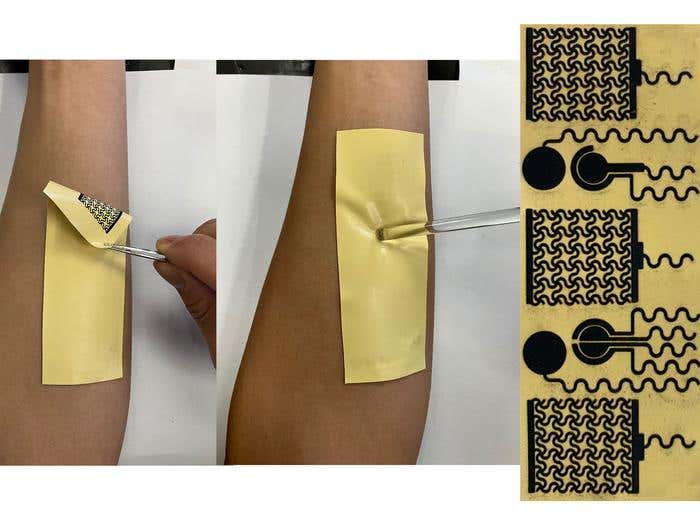New recyclable ‘smart skin’ provides real-time health monitoring
A newly developed smart skin can be efficiently reprogrammed to detect various signals and even recycled

Penn State researchers recently developed an adhesive sensing device that seamlessly attaches to human skin to detect and monitor the wearer’s health. The writable sensors can be removed with tape, allowing new sensors to be patterned onto the device. (CREDIT: Jia Zhu/Penn State)
Your skin naturally sends signals about your health, like feeling tight when it's dry to indicate the need for moisture. But imagine if your skin could do even more, like monitoring and sharing specific health information, such as the concentration of glucose in your sweat or your heart rate.
This idea has driven a team led by researchers at Penn State to develop an adhesive sensing device that seamlessly attaches to human skin to detect and monitor health indicators.
Details about this innovative smart skin, including its ability to be efficiently reprogrammed and recycled, were published in the journal Advanced Materials. This publication featured the work as part of the “Rising Stars” series, which highlights significant contributions from early career researchers worldwide. Additionally, the team has filed a provisional patent application for their work.
“Despite significant efforts on wearable sensors for health monitoring, there haven’t been multifunctional skin-interfaced electronics with intrinsic adhesion on a single material platform prepared by low-cost, efficient fabrication methods,” said Huanyu “Larry” Cheng, co-corresponding author and the James L. Henderson, Jr. Memorial Associate Professor of Engineering Science and Mechanics at Penn State. “This work introduces a skin-attachable, reprogrammable, multifunctional, adhesive device patch fabricated by simple and low-cost laser scribing.”
Cheng pointed out that traditional fabrication techniques for flexible electronics are often complex and expensive. These techniques involve sensors built on flexible substrates, which are not necessarily flexible themselves, limiting the device's overall flexibility. Cheng's team previously developed biomarker sensors using laser-induced graphene (LIG), a process that involves using a laser to pattern 3D networks on a porous, flexible substrate. This interaction between the laser and the materials produces conductive graphene.
Related Stories
“However, the LIG-based sensors and devices on flexible substrates are not intrinsically stretchable and can’t conform to interface with human skin for bio-sensing,” Cheng explained. Human skin changes shape, temperature, and moisture levels, especially during physical activity when monitoring heart rate, nerve performance, or sweat glucose levels is crucial. “Although LIG can be transferred to stretchable elastomers, the process can greatly reduce its quality.”
This difficulty in programming a sensor device to monitor specific biological or electrophysical signals, and the potential degradation in sensing performance, posed significant challenges.
“To address these challenges, it is highly desirable to prepare porous 3D LIG directly on the stretchable substrate,” said co-author Jia Zhu, who graduated with a doctorate in engineering science and mechanics from Penn State in 2020 and is now an associate professor at the University of Electronic Science and Technology of China.
The team achieved this by creating an adhesive composite with molecules called polyimide powders, which add strength and heat resistance, and amine-based ethoxylated polyethylenimine, a polymer that modifies conductive materials. This composite is dispersed in a silicone elastomer, or rubber. The stretchable composite not only allows for direct 3D LIG preparation but also adheres to non-uniform, changing shapes, such as human skin.
Experimental tests confirmed the device's ability to monitor pH values, glucose, and lactate concentrations in sweat, similar to what is detected via finger-prick blood draws. It can also be reprogrammed to monitor heart rate, nerve performance, and sweat glucose concentrations in real time.
Reprogramming involves applying clear tape over the LIG networks and peeling them off. The substrate can then be re-lasered to new specifications, up to four times before becoming too thin. When it becomes too thin, the entire device can be recycled.
Cheng emphasized that the device remains adhesive and functional even when the skin is wet with sweat or water. Currently, the device is powered by batteries or near-field communication nodules, like a wireless charger. However, there is potential for the device to harvest energy and communicate over radio frequencies, which could result in a standalone, stretchable adhesive platform capable of sensing desired biomarkers and monitoring electrophysical signals.
The team plans to work toward this goal in collaboration with physicians to eventually apply the platform for managing various diseases, such as diabetes, and monitoring acute issues like infections or wounds.
“We would like to create the next generation of smart skin with integrated sensors for health monitoring,” Cheng said. “This would allow us to evaluate how various treatments impact health and deliver drugs for in-time treatment.”
Note: Materials provided above by The Brighter Side of News. Content may be edited for style and length.
Like these kind of feel good stories? Get The Brighter Side of News' newsletter.
Joshua Shavit
Science & Technology Writer | AI and Robotics Reporter
Joshua Shavit is a Los Angeles-based science and technology writer with a passion for exploring the breakthroughs shaping the future. As a contributor to The Brighter Side of News, he focuses on positive and transformative advancements in AI, technology, physics, engineering, robotics and space science. Joshua is currently working towards a Bachelor of Science in Business Administration at the University of California, Berkeley. He combines his academic background with a talent for storytelling, making complex scientific discoveries engaging and accessible. His work highlights the innovators behind the ideas, bringing readers closer to the people driving progress.



